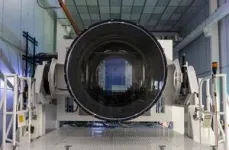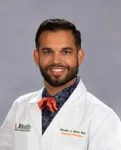(Press-News.org) (Santa Barbara, Calif.) — A collaboration between research groups at the University of California, TU Dresden in Germany and Cedars-Sinai Guerin Children’s in Los Angeles has identified a mechanism by which embryonic cells organize themselves to send signals to surrounding cells, telling them where to go and what to do. While these signaling centers have been known to science for a while, how individual cells turn into organizers has been something of a mystery.
Until now. In a paper published in the journal Nature Cell Biology, the researchers find that cells are literally pressed into becoming organizers.
“We were able to use microdroplet techniques to figure out how the buildup of mechanical pressure affects organ formation,” said co-corresponding author Otger Campàs, former associate professor of mechanical engineering at UC Santa Barbara, who is currently managing director, professor and chair of tissue dynamics at the Physics of Life Excellence Cluster of TU Dresden.
Peer pressure
Finding out how cells decide to become organizers during the formation of organs remains a central challenge in the study of embryogenesis, and is key to understanding embryonic development.
“By understanding how an embryo forms organs, we can start to ask questions about what goes wrong in children born with congenital malformations,” said fellow co-author Ophir Klein, MD, executive director of Cedars-Sinai Guerin Children’s, where he is also the David and Meredith Kaplan Distinguished Chair in Children’s Health.
Building on techniques previously developed by Campàs, in which minute droplets inserted between developing embryonic cells sense the forces exerted by cells on each other, and through observations of an embryonic incisor tooth, the researchers found that pressure influences a cell’s fate — they feel the squeeze and use this information to organize themselves.
“It’s like those toys that absorb water and grow in size,” said Neha Pincha Shroff, a postdoctoral scholar in the School of Dentistry at UCSF, and co-lead author of the study. “Just imagine that happening in a confined space. What happens in the incisor knot is that the cells multiply in number in a fixed space and this causes a pressure to build up at the center, which then becomes a cluster of specialized cells.” The researchers found that the cells feeling the stronger pressure stop growing and start sending signals to organize the other surrounding cells in the tooth.
Embryos use several of these signaling centers to guide cells as they form tissues and organs. Cells around these centers receive stronger or weaker signals depending on their location, and they make decisions accordingly. Like building skyscrapers or bridges, sculpting our organs involves tight planning, a lot of coordination and the right structural mechanics. Failure in any of these processes can be catastrophic when it comes to building a bridge, and it can also be damaging for us when growing in the womb.
“This work may lead to additional research into how birth defects are formed and can be prevented,” Klein remarked.
Seeing how pressure works in embryonic development opens up further research possibilities, according to Campàs.
“It is really exciting that pressure has a role in establishing signaling centers,” he said. “It will be interesting to see if or how mechanical pressure affects other important developmental processes.”
Investigators Pengfei Xu (co-first author), Sangwoo Kim, Elijah Shelton, Ben Gross, Yucen Liu, Carlos Gomez, Qianlin Ye, Tingsheng Yu Drennon, Jimmy Hu, and Jeremy Green also participated in the study.
END
Pressure determines which embryonic cells become ‘organizers’
2024-04-03
ELSE PRESS RELEASES FROM THIS DATE:
Global rollout of Skin Observer by NAOS and Haut.AI in 2024
2024-04-03
Tallinn, 3rd April 2024 - 10 AM CET – NAOS, the French founding company behind pioneering ecobiological skincare brands BIODERMA, Etat Pur, and Institut Esthederm, introduces its innovative new digital tool Skin Observer in collaboration with Haut.AI, a leader in AI applications for skincare and skin aging. The partnership merges cutting-edge AI technology with deep expertise in skin ecobiology.
Developed in collaboration with dermatologists, NAOS Skin Observer offers quick and precise skin analysis, recommending customized rituals adapted to individual skin types. The system adjusts routines based on user preferences, dynamic skin ...
New Paradigm of Peace through Health: Traditional Medicine Meditation in the Prevention of Collective Stress, Violence, and War
2024-04-03
A breakthrough perspective article in Frontiers in Public Health, "Peace through Health: Traditional Medicine Meditation in the Prevention of Collective Stress Violence and War," sheds light on the profound impact of the Transcendental Meditation (TM) program on fostering global peace. The article reviews and analyzes the demand for public health and medicine to help prevent collective violence and “intractable” wars in the Middle East, Eastern Europe, Africa and elsewhere and ...
Machine learning enables viability of vertical-axis wind turbines
2024-04-03
If you imagine an industrial wind turbine, you likely picture the windmill design, technically known as a horizontal-axis wind turbine (HAWT). But the very first wind turbines, which were developed in the Middle East around the 8th century for grinding grain, were vertical-axis wind turbines (VAWT), meaning they spun perpendicular to the wind, rather than parallel.
Due to their slower rotation speed, VAWTs are less noisy than HAWTs and achieve greater wind energy density, meaning they need less space for ...
E-cigarette users now more likely to quit traditional cigarettes
2024-04-03
A new paper in Nicotine & Tobacco Research, published by Oxford University Press, finds that smokers who switch to electronic cigarettes are now more likely to stop smoking regular cigarettes. In the past, smokers who began using electronic cigarettes mostly continued smoking.
Electronic nicotine delivery systems first emerged on the U.S. market in 2007. The first e-cigarettes resembled conventional cigarettes (in appearance) and used fixed low-voltage batteries. Beginning in 2016, manufacturers introduced e-liquids containing nicotine salt formulations. These new e-cigarettes became widely available. These nicotine salts are lower in pH than freebase formulations, which allow manufacturers ...
Chatbot guides women through post-prison challenges
2024-04-03
Most women leaving prison face profound disadvantages and rarely have access to the resources needed to settle back into the community. Seemingly simple tasks such as obtaining replacement identification documents or opening a bank account become tangled in complexities.
Now researchers at the University of South Australia are co-designing a chatbot to help formerly incarcerated women re-establish their lives on the outside, and reduce the risk of them returning to prison.
Led by a team of UniSA researchers in collaboration with advocacy group Seeds of Affinity, the tech-based solution aims to help women access trusted ...
Doctors on front line of tackling childhood obesity but more training and resources needed
2024-04-03
Doctors are feeling unable to tackle growing problem of childhood obesity due to a lack of training and capacity according to new research.
In a paper published in the British Journal of General Practice, researchers from the University of Birmingham conducted in-depth interviews with healthcare professionals (HCPs) to understand their experiences of supporting families to tackle childhood obesity.
One participant in the study said:
“I had one mum and her child was overweight, but she was a young parent and she actually didn’t know how to cook the dinners and, yeah… we spent a lot of time with her giving her ...
Galaxies get more chaotic as they age
2024-04-03
Galaxies start life with their stars rotating in an orderly pattern but in some the motion of stars in more random. Until now, scientists have been uncertain about what causes this – possibly the surrounding environment or the mass of the galaxy itself.
A new study, published in a paper today in MNRAS (Monthly Notices of the Royal Astronomical Society), has found that the most important factor is neither of these things. It shows the tendency of the stars to have random motion is driven mostly by the age of the galaxy – things just get messy over time.
“When we did the analysis, we found that age, consistently, whichever way we slice or dice it, is always the most ...
Sandia pumps $140B into the economy through technology development
2024-04-03
ALBUQUERQUE, N.M. — To say that the technology and products Sandia National Laboratories researchers have helped imagine, innovate and industrialize have had a massive impact on the country would be an understatement.
Two studies commissioned by Sandia and the National Nuclear Security Administration show Sandia’s work has had an overall economic impact of $140 billion since the year 2000. That’s a significant figure, especially considering it spans just 20 years, less than a third of Sandia’s 75-year existence.
“I am very proud of how Sandia excels in fulfilling its technology transfer mission to deliver economic impact to the U.S.,” ...
Even moderate alcohol usage during pregnancy linked to birth abnormalities, UNM researchers find
2024-04-03
University of New Mexico researchers have found that even low to moderate alcohol use by pregnant patients may contribute to subtle changes in their babies’ prenatal development, including lower birth length and a shorter duration of gestation.
In a new paper published in the journal Alcohol Clinical & Experimental Research, a team led by Ludmila Bakhireva, MD, PhD, MPH, professor and assistant dean for Clinical and Translational Research in the UNM College of Pharmacy, also reported some sex-related differences in the effects of drinking during pregnancy on the developing ...
Sylvester physician co-authors global plan to combat prostate cancer
2024-04-03
MIAMI, FLORIDA (EMBARGOED UNTIL APRIL 4, 2024, at 6:30 pm EDT) – Annual prostate cancer cases worldwide are projected to double by the year 2040, and annual deaths are projected to increase by 85% to almost 700,000 over the same timeframe – mainly among men in low- and middle-income countries. A commissioned report published online in The Lancet on April 4 highlights the future landscape of prostate cancer and seeks to guide cancer experts worldwide on how to manage the massive influx of prostate cancer patients projected over the next two decades.
Brandon Mahal, M.D., radiation oncologist and ...







